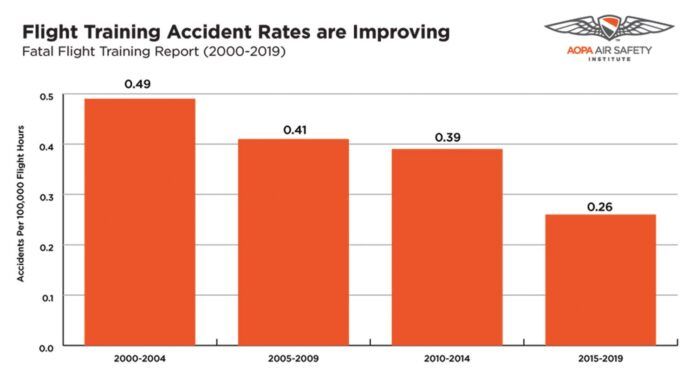There’s good news on the safety of flight training operations, according to a study from the AOPA Air Safety Institute and Liberty University’s School of Aeronautics. The two recently released a report based on their study showing, in part, a nearly 50-percent reduction in the fatal accident rate for the 20 years beginning in 2000 and concluding with 2019.
The improvements some via “sustained efforts” throughout the flight-training industry, according to the executive summary, leading to a nearly 50-percent reduction in fatal accidents over the period.
While flight training activity suffered a decline during the early part of the period, it has rebounded in recent years, even as the fatal accident rate has been almost halved. According to the report’s conclusions, “The fatal instructional accident rate average decreased from 0.49 in the first five years of our study to 0.26 in the last five years of our study.”
Also according to the report’s executive summary, “flight training” was defined as “both dual and solo operations that were categorized by the NTSB as ‘instructional’. The study was restricted to U.S. accidents involving “fixed-wing, piston singles, and light twins with reciprocating engines under 500 horsepower per engine.”
Excluded from the study were foreign accidents, those involving experimental and light-sport airplanes, multi-engine airplanes with seven or more seats and singles with more than 500 horsepower.
Accident scenarios with the most lethality during the period included in-flight loss of control, mid-air collisions and controlled flight into terrain. These mishap causes closely track those for the industry as a whole.
The report concludes that new technologies available in the flight training environment “may have contributed” to the safety improvements. They include: “angle of attack indicators, flight envelope protection, traffic displays, moving map displays, and terrain overlays. Furthermore, many flight training providers operate newer fleets with modern avionics and crash restraints including shoulder harnesses and airbags.”
The report acknowledges that changes in FAA policy during the period “permitted the installation of many of these devices at lower price points allowing for greater fleet adoption.”
Other changes, according to the report’s conclusions, include a renewed emphasis on recovering from stalls, and “the importance of reducing the angle of attack (AOA) as the first and primary step in stall recovery.”
Increased levels of standardization may also be credited with the improvement, the study concludes, along with the FAA’s emphasis on risk management as part of its recent airmen certification standards overhaul.
Although there probably are many lessons available from the study, one observation bears highlighting here. According to the study’s conclusions, the majority of examined midair collisions “occurred at VFR/IFR altitudes, even though pilots can maneuver at any altitude when below 3,000 feet agl. It seems that instructors select a target altitude such as 2,500 feet msl or 3,000 feet msl, where an analog altimeter needle would point straight up or straight down. A simple training mitigation may be to select a less congested altitude such as 2,700 feet msl, which deconflicts from IFR and VFR cruising flights.”
The study’s report has been published online.




